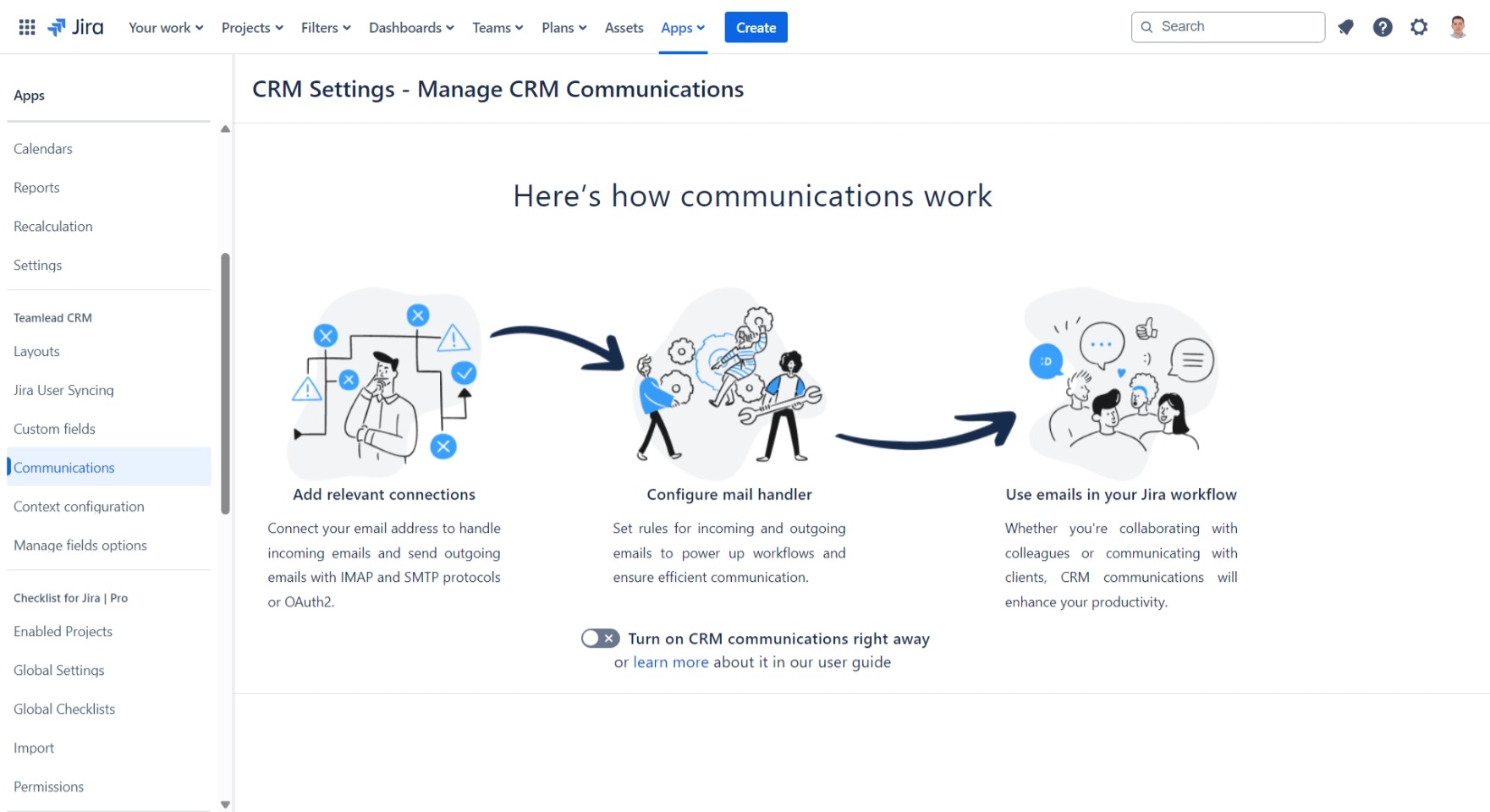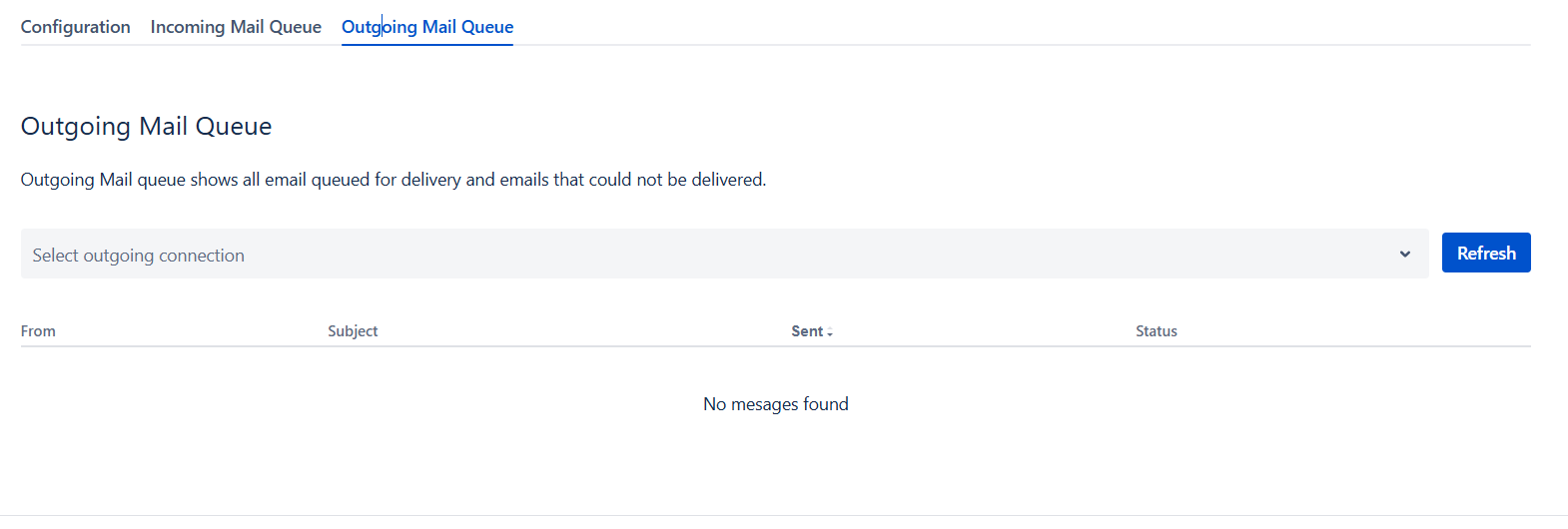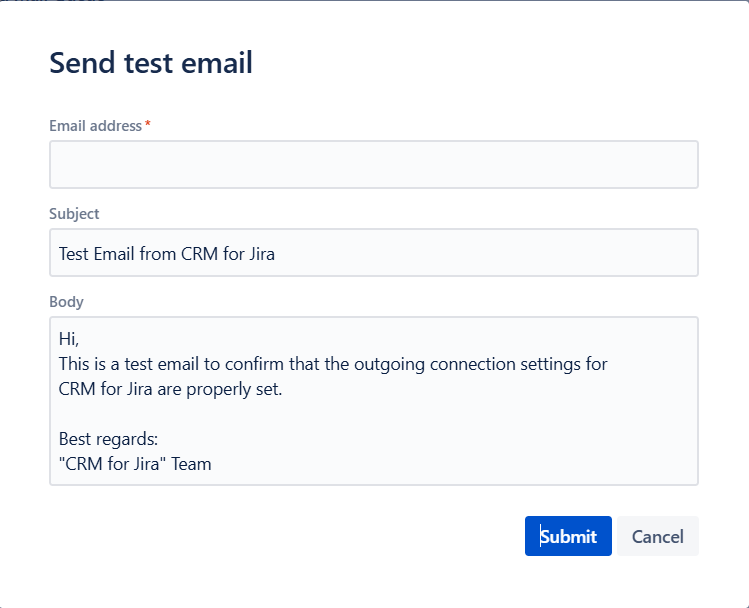Configuring Communications
The CRM Communications feature enables you to interact with non-Jira users directly from the Jira interface. To set this up, follow these steps:
Configure Company and Contact custom fields: Add Company and Contact custom fields to issue screens where you plan to use CRM Communications.
Activate CRM Communications and add Email Connections: Configure both incoming and outgoing email connections.
Currently OAuth 2.0 is not supported by the app but this feature is in our roadmap!
Create a Default Reporter: Since issues created by non-Jira users require a reporter, you need to set up a default reporter that will automatically be assigned to all newly created issues. We recommend creating a dedicated technical Jira user for this purpose, but you can choose any existing user as the default reporter. While the default reporter is necessary for issue creation, it is not essential for CRM communication. Once the issue is created, you can change the reporter if it will better fit your workflow.
Currently default Reporter is used to create issues, and at the time of issue creation, the system cannot automatically determine the company associated with the user. As a result, the Automatic linking mode is not compatible with CRM Communications.
Configure the Mail Handler: Set up the mail handler to manage how emails are processed. The app employs the "Create issues or comments from email" mail handler type for this purpose and can automatically generate issues or comments from incoming emails.
CRM Communications is currently not compatible with JSM projects.
Let's take a closer look at these steps:
Step 1: Configure Company and Contact custom fields
Navigate to Settings → Issues.
Go to Custom fields.
Add Company and Contact custom fields to issue screens where you plan to use CRM Communications.
If these fields are already configured, you can skip this step.
Step 2: Activate CRM Communications
Navigate to Manage Apps.
Go to CRM → Communications.
Activate the feature using the toggle switch.

Step 3: Add Incoming Connection
This connection is your email account where you will receive emails. Currently, only IMAP is supported.

If you need POP3 or another type, you can request it on our Customer portal.
If you need to verify which emails were not recieved, navigate to Manage Apps → CRM → Communications → Incoming Mail Queue. The "Incoming Mail Queue" tab displays a table of incoming emails that are either in the process of being handled or have encountered errors during processing.

Configuration Settings:
Parameter | Description |
|---|---|
| Name for the connection. |
| The email address or username used to authenticate with the IMAP server. Depending on your email provider, this is usually either your full email address or just the part before the "@" symbol |
| The password associated with the username for authentication. |
| The hostname or IP address of the IMAP server. |
| The port number used for the IMAP connection. Common ports are 143 for unencrypted connections and 993 for SSL/TLS-encrypted connections. |
| The security protocol used to protect the connection. Options include: |
| Duration the email client waits for a response from the IMAP server before considering the connection attempt as failed |
Once all parameters are entered, click the "Test Connection" button to verify that everything is working correctly.
Here you can find the IMAP settings for popular email providers:
If you are using a corporate email adress, contact your mail server administrator to obtain the required IMAP settings.
Step 4: Add Outgoing Connection
This connection is your email account from which you will send emails. The incoming and outgoing email accounts do not need to be the same. Currently, only SMTP is supported.

If you need another type, you can request it on our Customer portal.
If the admin needs to verify which emails were not sent, they can navigate to Manage Apps → CRM → Communications → Outgoing Mail Queue. The "Outgoing Mail Queue" tab displays a table of outgoing emails that are either being processed or have encountered errors during processing.

Configuration Settings:
Parameter | Description |
|---|---|
| Name for the connection. |
| The username for authenticating with the SMTP server. Depending on your email provider, this is usually either your full email address or just the part before the "@" symbol |
| The password associated with the username for authentication. |
| The hostname or IP address of the IMAP server. |
| The port number used for the SMTP connection. Common ports are 25 for unencrypted connections, 465 for SSL/TLS-encrypted connections and 587 for STARTTLS connections. |
| The security protocol used to protect the connection. |
| Duration the email client waits for a response from the SMTP server before considering the connection attempt as failed |
After entering all parameters and saving the Outgoing Connection, you can send a test email to ensure everything is functioning correctly. To do this, click the icon in the Outgoing Connections table and send test email.


Here you can find the SMTP settings for popular email providers:
If you are using a corporate email adress, contact your mail server administrator to obtain the required SMTP settings.
Step 5: Configure Mail Handler
Define how to handle incoming and outgoing emails.

The following table contains the available settings:
Parameter | Description |
|---|---|
Name | Name for the mail handler. |
Project | Determines which project new issues will be assigned to. Currently, the Mail Handler is limited to handling a single project. |
Issue Type | Specifies the type of issue (e.g., bug, task, or story) that will be used by default when new issues are created. |
Default Reporter | Jira user, which will be used if the email address in the From field of any received messages does not match the address associated with that of an existing Jira user |
Incoming mail connection | This connection is your email account where you will receive emails and which you've configured on Step 2. |
After download | Determines the actions that should be applied to the messages once they have been successfully downloaded from the server. |
Folder | Virtual container where emails are organized and stored. |
Outgoing mail connection | This connection is your email account from which you will send emails and which you've configured on Step 3. |
From Address | If the checkbox is enabled, the Jira User Name will appear as the sender's name on all outgoing messages (emails). If the checkbox is disabled, you can specify a default sender name (such as your company name, for example) in the "Add custom name for all emails" field. |
Regexp to filter attachments | Emails may contain unnecessary attachments without extensions. Use this option to get rid of them. Type in regular expression to filter all files without extension
CODE
To filter all attachments with a specific name (for example for JIRA-generated files) use the following regular expression:
CODE
|
Filter embedded images | If specified, the embedded images up to a particular size (see the next setting) will be deleted. If the Handler deletes any attachment from the comment it will inform about it at the end of the comment: "The following attachments were deleted:" |
Filter embedded images by size (Kb) | All embedded images up to this size will be deleted if the Filter embedded images option is selected. |
Images types | All embedded images of these types will be deleted. |
CC to contacts | If selected, a new CRM contact will be created for each of the users from CC with an unrecognized address. New CRM contact is created for each of the users from TO with an unrecognized address by default |
Participants linking | If selected, all Participants (non-Jira users who send emails) that were added as CRM contacts will be linked with the company selected in the issue. If the company is changed in the issue, the Participants (if they are CRM contacts) will be linked to the new company while maintaining their association with the previous company. Additionally, it will be possible to send emails to any user linked to company. |
Bulk | Action that will be performed for emails with the 'Precedence: bulk' or emails with an 'Auto-Submitted' header that is not set to "no". |
Forward Email | If specified, then if this mail service is unable to handle an email message it receives, an email message indicating this problem will be forwarded to the email address specified in this field. |
Strip Quotes | If checked quoted text is removed from comments based on the split regex. |
Split Regex | A regular expression matching the text that separates the content of the email message mail body from other (replied or forwarded) content in the body. |
Notifications | The CRM contact selected in the issue will receive email updates about status changes, provided their email address is included in the contact details. |
Catch Email Address | If set, only emails having the specified recipient in fields To, Cc will be processed. |
Custom footer | This footer will be included in messages sent through the app. |
Don’t forget to activate Mail Handler!

Keep in mind that when the mail handler is activated, it processes all unread emails from the current day. If there are any unread messages, the handler will process them and create corresponding issues.
.png)